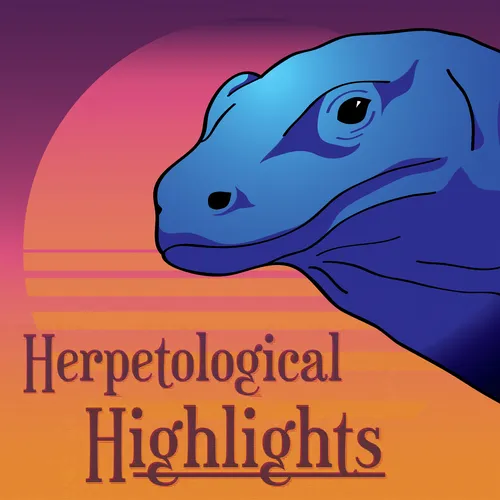
Herpetological Highlights
In Herpetological Highlights we will explore the recent scientific discoveries in the field of Herpetology. We'll cover everything from lizards to frogs, snakes, and toads. Every episode we'll be digging into the biology and ecology of these reptiles and amphibians in an attempt to disentangle the science. Hosted by Tom Major and Ben Marshall. Like us on facebook: www.facebook.com/herphighlights
- Update frequency
- every 7 days
- Average duration
- 49 minutes
- Episodes
- 238
- Years Active
- 2017 - 2025

135 I should have stayed an egg
A look at the world's shortest-lived tetrapod, a tiny chameleon, Labord's chameleon. What is their life like? And where do they go in the short months when they are not an egg?

134 For Rattlesnakes, Wetter is Better
Reptiles can be tough, especially when faced with a lack of water. But does providing them with extra water help them out? We also have a bent-toed Species of the Bi-week.

133 Tale of the Caledonian Castaways
The islands of New Caledonia are famous for their geckos. Recent research has revealed the evolutionary past of these sticky lizards, and it all began shortly after the islands themselves emerged fro…

132 Radioactive Colour Changing Frogs
Radioactive frogs around Chernobyl haven't been the same since the nuclear disaster. We talk about why they aren't so green, before focusing on a newly described species that couldn't be greener.

131 Invasion of the Lung Crustaceans
We’ve chatted about invasive species in many episodes, but this time the invader is INSIDE the better known invader. A parasite has made its way to Florida, USA in the lungs of Burmese Pythons; has t…

130 Versatile Blue Tongue
Blue tongue skinks are named for their distinctive blue tongue. We’ve talked previously about how they spook predators with a flash of blue, but this time we look at an alternative more food focused …

129 Fast Food is Bad for Turtles Too
A tortoise and turtle double-bill. Gopher tortoises face burrow cave-ins, and sea turtles eat human food.

128 Swampy Siren Songs
Sirens resemble a salamander crossed with an eel. We work out how these bizarre amphibians hunt, and talk about a siren species only recently discovered by science.

127 Frog Calls in a Concrete Jungle
Animals have to adapt to all sorts of changes, but urbanisation is perhaps one of the most drastic. Urban noise can majorly interfere with communication, so how do frogs overcome the noise and busyne…

126 The Salamanders That Parachute
Is it a bird? Is it a plane? No it’s a Plethodontid Salamander, more specifically Aneides vagrans AKA the wandering salamander. As strange as it sounds we look at a gliding salamander this episode. S…

125 Last of the Giant Lizards
Many large animals have gone extinct in the last 50,000 years - but not Komodo dragons. We explore a paper detailing why they have survived while other megafauna have not.

124 Garter Snake Gangs
Snakes are often thought of as totally solitary, but this isn't always the case. We talk about a new study detailing snake social behaviour, and follow it up with two recently described frog species …

123 Fantastic Mr Foxsnake
Foxsnakes are widely distributed and with an apparently tumultuous taxonomic history, but we can still take a look at the habitats they prefer and their ability to traverse fragmented landscapes.

122 Volcano Lizards
Lizards can live in some tough environments, but does any lizard top the chubby Phymaturus living on the side of an active volcano? This episode we explore how they are coping with repeated ashfall e…

121 The Cheeky Startler
Toad headed agamas have a bonkers display - bright pink flaps which pop out of the sides of their head. It has long been assumed this serves as a warning to would-be predators, but does scientific ev…

120 Vipers With Eyebrows
Some vipers have crazy horns - we chat about it, and discuss a brand new species of lizard from South America.

119 Crocodile Comeback
Despite existing on the planet for millions of years with minor morphological changes, crocodiles are having a difficult time in a new human dominated world. However, there are success stories. This …

118 The Frogs That Cannot Hop
Animals come in many sizes, great and small. But all are subject to the laws of physics. In this episode we look at how the tiniest of frogs are too small to elegantly jump. Species of the Bi-week re…

117 Predation Liberation - Shine on Chameleons
Jackson's chameleons are famous for their bright colours and fancy horns. But can a lack of predators make them even jazzier?

116 The Unfamiliar Scent of Death
Can the smell of predators put lizards off their lunch?
Become a Patreon: https://www.patreon.com/herphighlights
Full reference list available here: http://www.herphighlights.podbean.com
Main Paper…